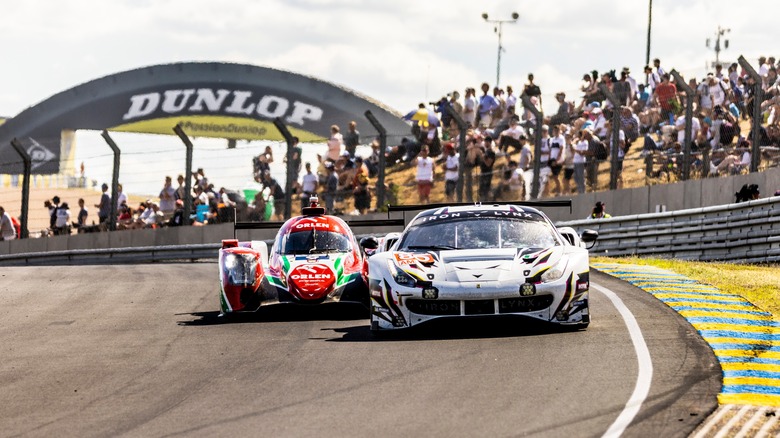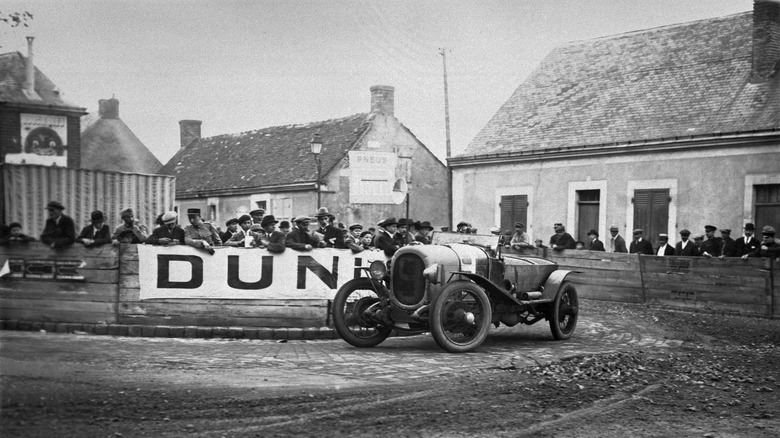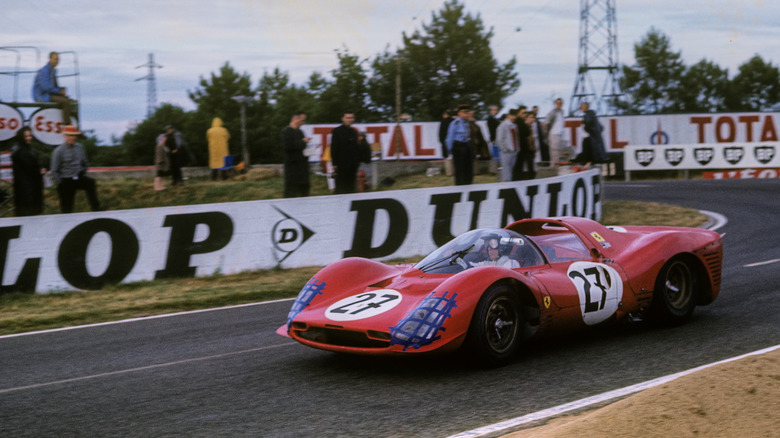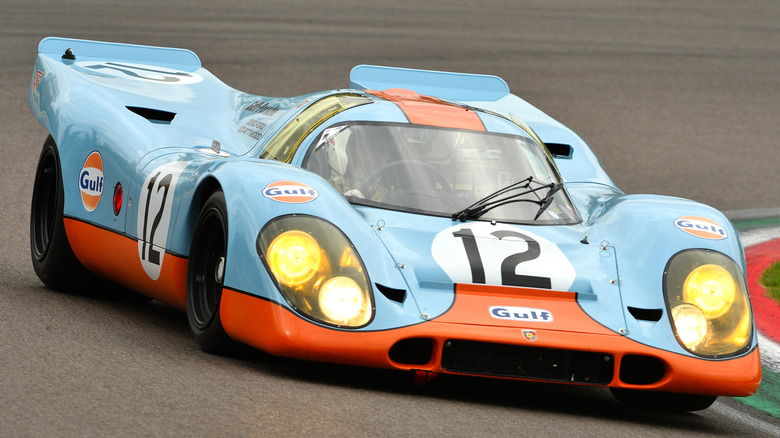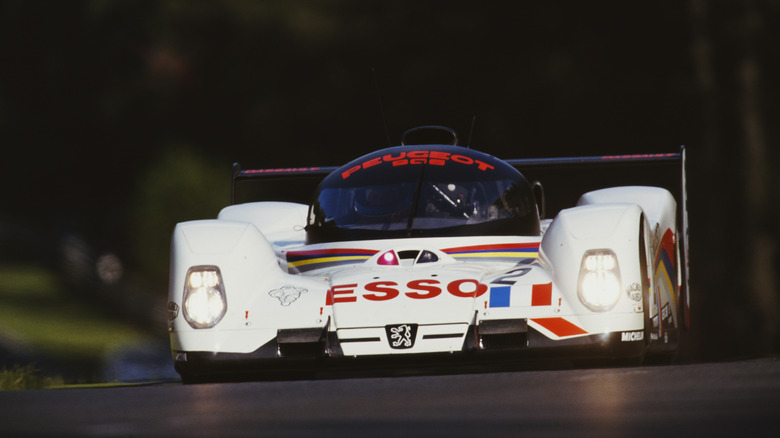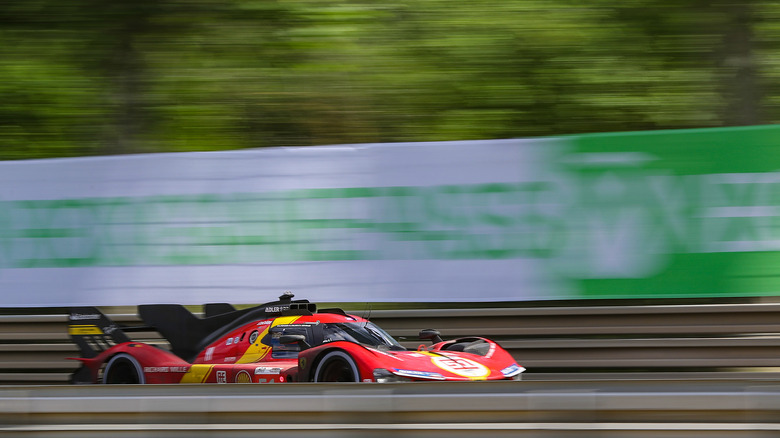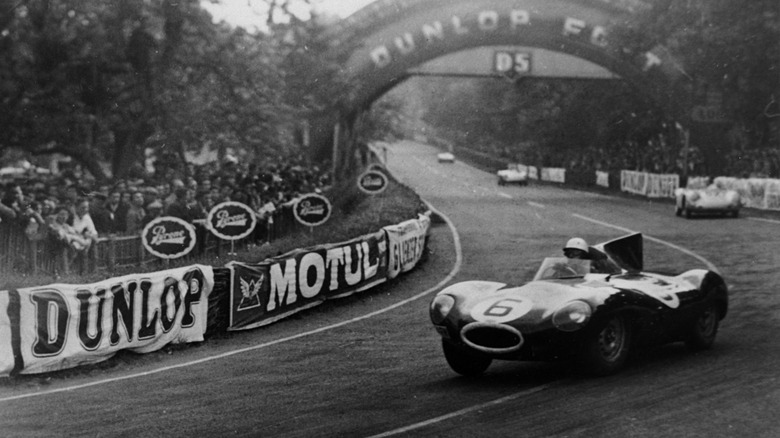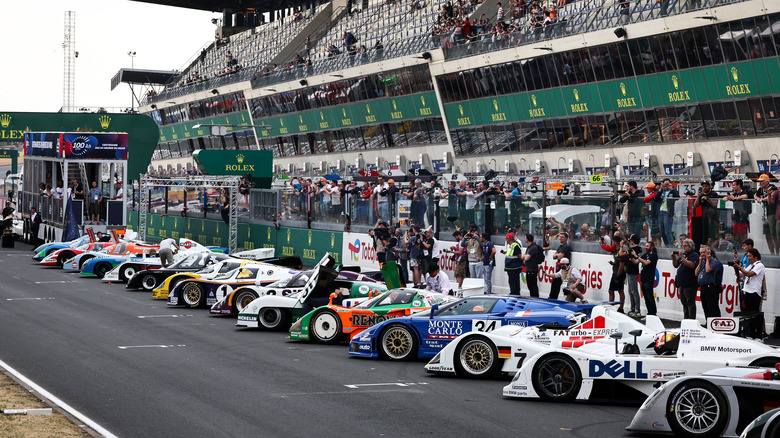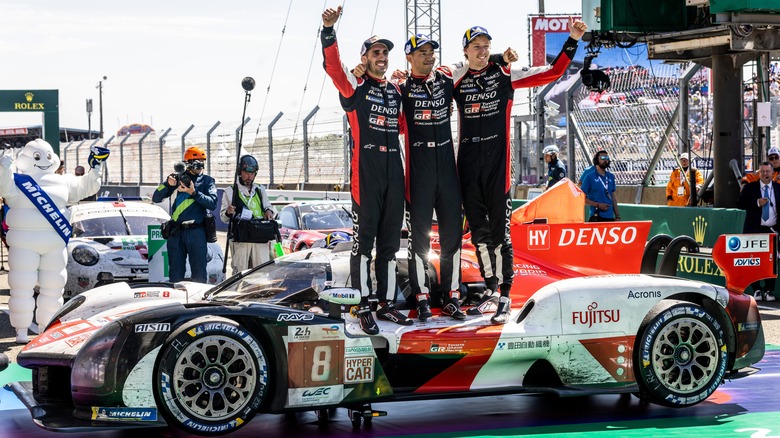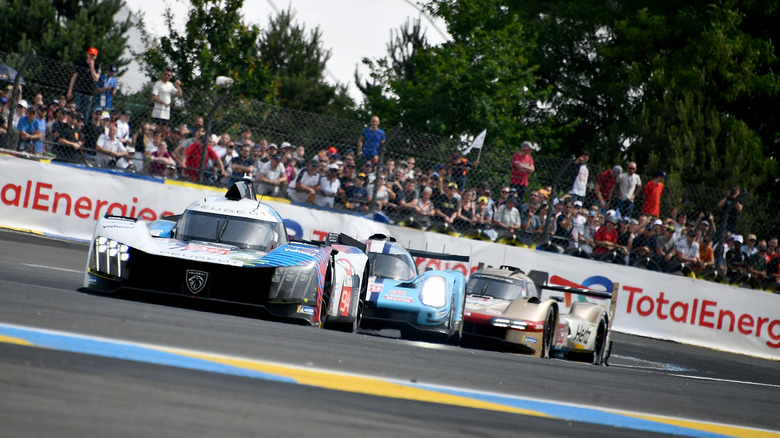24 Hours Of Le Mans: The History Behind Motorsport's Greatest Race
The north-western French town of Le Mans will forever be synonymous with the brutal 24-hour endurance race that takes place on its Circuit de la Sarthe each year. Established in 1923, the 24 Hours of Le Mans is the oldest sports car race of its type in the world, and it makes up one-third of the "triple crown of Motorsport" that includes the Indianapolis 500 and Monaco Grand Prix. It's become known both for its punishing distance and many tragedies, alongside top speeds that exceed 225 miles per hour on the course's Mulsanne straight.
In the 1971 film "Le Mans," Steve McQueen famously said, "When you're racing, it's life. Anything that happens before or after is just waiting." This became one of the most quoted phrases in motorsport, and it perfectly summarizes the attitude required of every driver in the 24 Hours of Le Mans. This is more than a race, as it tests not only the cars but also the drivers to the absolute limits of their abilities as they compete to drive the most laps of the 8.5-mile circuit in a single day, with many cars covering over 3,000 miles in total.
Regarded as the greatest race on the motorsport calendar, the 24 Hours of Le Mans is legendary in the eyes of racing fans, moviegoers, and the public at large, thanks to a host of documentaries and films that include the aforementioned "Le Mans" and more recently, "Le Mans 66," otherwise known as "Ford vs. Ferrari."
The Early Years
The 24 Hours of Le Mans turned 100 in 2023, but its roots go back to 1922's Paris Motor Show when three heavily-mustachioed Frenchmen, Georges Durand, Emile Coquille, and Charles Faroux, decided to launch an endurance race to rival Italy's Mille Miglia and the set-distance motorcar races of its day. This type of race was an ideal platform for automobile brands to not only showcase their cars' performance abilities but also demonstrate their durability on the world's stage.
Thus, the world's most famous endurance race began, with great European marques like Bentley, Alfa Romeo, and Bugatti dominating in the early years. Unlike today's dedicated circuit, which only partially encroaches public roadways, the entire racewas held on the streets of Le Mans and named after the Sarthe river that ran through the town. The Le Mans tradition grew in popularity until 1936, when public strikes halted the proceedings, and again in 1939 when World War Two intervened. It wasn't until a decade later, in 1949, that a revitalized race was resurrected, with more brands competing than in pre-war races and some now-legendary marques starting to make an impression on the first races of the new era.
The 1950s and 1960s
The new generation of the 24 Hours of Le Mans came to be a golden age of motorsport as a host of new manufacturers joined the ranks of competitors, including Jaguar, Aston Martin, Mercedes-Benz, and Ferrari. Mercedes proved to be a formidable contender, having placed first and second in the 1952 race in the stunning gull-winged 300 SL, although Jaguar dominated the 1950s with an impressive five wins. This era's racing was highly aggressive, as the 24 Hours of Le Mans became as much about speed as it was a showcase for reliability and endurance. Yet safety measures had yet to catch up, resulting in the 1955 Le Mans Disaster in which Frenchman Pierre Levegh's Mercedes 300 SLR suffered a collision that sent him into a crowd of spectators, killing himself and 83 others. While tragic, this event highlighted a concern for better safety in motorsports, although Mercedes stayed away from racing for some years.
The 1960s became one of the most memorable decades in Le Mans history, as Ferrari debuted its glorious 250 Testarossa and 250 GTO (which would come to be two of the most expensive cars ever to be auctioned), as well as the successful P series of cars which included the 330 P3. Ferrari's incredible run of six consecutive wins and eighteen podiums between 1960 and 1965 was suddenly challenged by the Ford GT40 in what was to become one of the biggest upsets to the Prancing Horse in Enzo Ferrari's racing career. This was the race that was immortalized in the film "Le Mans 66" starring Christian Bale and Matt Damon, and Ford dominated the rest of the decade with four wins for the GT40, as Porsche started to show its potential as the U.S. giant's leading contender.
The 1970s and 1980s
The 1970s started with a triple podium for Porsche, followed by another win in 1971. Ferrari withdrew its Prototypes from Le Mans in 1973 following the previous decade's disappointment, looking to focus exclusively on Formula One. This leveled the playing field for other marques, including Matra-Simca and Renault-Alpine, to rise, although Porsche would dominate the next two decades in both the Prototype and GT classes.
The late 1960s and early 1970s saw a significant distinction between the Prototype and GT cars. Models like the 1970 Porsche 917 and Matra-Simca No.11 introduced a new era of bespoke high-performance machines characterized by their low profiles, large chassis', sunbed-sized rear spoilers, outsized wing-mounted headlamps, and bubble-like windshields.
Porsche Prototypes took all three podium places in 1982, with the Belgian and Briton Jacky Ickx and Derek Bell finishing first in the incredible Porsche 956. This kicked off an impressive run for the Stuttgart-based brand as the 956 dominated the Le Mans circuit more than any other car in history, winning the top seven positions in 1984, the top five in 1985 and 1986, and finishing first and second in 1987. In 1988, the WM P88 Peugeot, piloted by Richard Dorchy, hit a whopping 252 miles per hour on the Mulsanne Straight, setting a Le Mans record yet to be broken. Impressive as this may be, Dorchy did not finish, as his car failed him soon afterward due to this costly case of overreaching.
The 1990s and 2000s
The 24 Hours of Le Mans is ever-changing, perhaps more so than any other race, due to its multiple classes and competitors that add far more diversity than other elite competitions like the World Rally Championship and Formula One. The 1990s were a time of flux as older brands started to re-emerge, such as Jaguar with its XJR-12 and Peugeot with its 905, and new contenders started to appear, such as the Japanese Toyota with its 92C-V and Mazda with its 1991 race-winning 787B.
The status quo was further shattered in 1995 with the introduction of the McLaren F1 to the GT class, which beat all the Prototype class cars of that year, with three more finishing in the top five positions in a dramatic and rain-soaked race. 1996 saw a return to Le Mans for Ferrari in the GT class, and Porsche retired its Prototypes two years later, following a very successful tenure.
The 1990s ended with BMW starting to shine, and another German team, Audi, dominated the next decade with its R8 and R10 winning all but two races in a remarkable introduction to endurance racing as Danish driver Tom Kristensen began his record-breaking run of wins. This time saw exciting additions to the GT class, with cars like the Corvette C6R, Porsche 911, Panoz Esperante GT-LM, Ferrari 459 Italia, and the new Ford GT adding some welcome flavor to the race.
2010 thru present day
Tom Kristensen continued his run of wins while piloting the awesome Audi R18 in the new decade, one of the most interesting designs not just of an endurance race car but of race cars in general. With its four protruding wings and large perpendicular fin that runs along its length, it looks like a cross between a contemporary Le Mans Hypercar and a Formula One car. In this machine, Audi dominated the class until 2015, when Porsche snatched victory from its compatriot marque with its 919 Hybrid. This was bad news for Audi, but good news for environmentally-conscious racing, as Porsche proved that EVs could be competitive as they won again with the same car the following two years.
Toyota picked up the baton for cleaner energy, winning the next five races in the Gazoo Racing T050 and GR010 hybrids between 2018 and 2022. Following this, the FIA began to take renewable energy seriously by introducing a hybrid hydrogen-electric class in 2025. The hybrids' winning streak was since broken in 2023 by the formidable Ferrari 499P, as the Scuderia made its return to the elite class of the 24 Hours of Le Mans after a 50-year hiatus, making its presence known in typically flamboyant style. This is almost certainly the most unpredictable race on the motorsport calendar due to its sheer number of competitors and the number of laps required. One thing is for sure: the future of Le Man will never get boring.
The rules
The rules of the 24 Hours of Le Mans have changed over the years as evolving technology and safety considerations have influenced how the race is run. There are two sets of rules governing the race, one pertaining to the drivers and the other to the cars. Driver and spectator safety are paramount, especially since the catastrophic crash in 1955. Since then, driver experience has been a significant consideration, with each given a ranking of bronze, silver, gold, or platinum. Bronze status is given to entry-level drivers with the requisite experience to partake in the race; Silver status to serious contenders who are still relatively inexperienced; Gold status to professional paid-up drivers, and Platinum status to racing drivers who are sponsored by one of the teams or have enjoyed a professional racing career. Drivers can then only compete within their corresponding division.
One rule since eradicated was the controversial "standing start," whereby drivers would have to run to their cars, leap in, and start from stationary. This was changed from a standing start with drivers already seated in 1970 to a rolling start in 1971, which is still in practice today. Cars are categorized into either Prototype or GT categories. The Prototypes are non-homologation, bespoke cars, representing the event's most elite vehicles. These are subdivided into either Hypercar (previously LMP1), LMP2, or the newer LMP3 class. GT cars are homologated roadgoing production vehicles further subdivided into LM GTE (Grand Touring Endurance) Pro and Am (professional and amateur) classes.
The cars
There are approximately 60 cars in every 24 Hours of Le Mans competition, each with unique properties. These are the real stars of the show. Governing requirements and standout contenders have helped categorize the types of cars throughout this race's storied history. The 1924 Bentley Speed Six represented the types of cars in the race's fledgling days. This open-topped, six-cylinder factory racing model was a five-time winner, but by the mid-1930s, designs became sleeker and more aerodynamic. Cars like the Bugatti 57G featuring an enclosed coupe design represented what Le Mans racers would become. In the 1960s, Ford and Ferrari battled it out with the GT40 and 330 P3, respectively. These cars demonstrated the evolution of the Le Mans Prototype as a rear-engine two-seater with a low, aerodynamic profile, wide chassis, and long wheelbase; a configuration that has been used ever since in cars like the 1970 Porsche 917, 1991 Peugeot 905, and 2013 Audi R18.
This evolution was dictated by the demands of the Le Mans circuit, with its long straights enabling drivers to test their cars' maximum speeds. Cornering speeds were secondary in the early days. Significant differences between the Prototype and GT cars evolved gradually, as the latter roadgoing vehicles lacked the bespoke designs with their extensive bodywork and massive spoilers that provided more downforce, enabling faster cornering. Despite some general similarities in design, Le Mans has always been reminiscent of the "Whacky Races" cartoon, with some genuinely bizarre cars having participated over the years.
The drivers
While a Formula One or IndyCar driver has to demonstrate remarkable skill and stamina over the course of a race, the 24 Hours of Le Mans requires incredible focus and tenacity. Just as some drivers have secured a place for themselves in the annals of racing history as champions at the Circuit de la Sarthe, many have paid the ultimate price while chasing the Le Mans dream. Le Mans drivers could be categorized into those that are the most successful and those that are the most notorious. Topping the most successful list is "Mr. Le Mans," Tom Kristensen of Denmark, with an incredible nine victories between 1997 and 2013, scoring the most wins for Team Audi. He also bagged an impressive six wins at the Sebring 12-hour race, making Kristensen the undisputed king of endurance racing.
Belgium has produced two of the six top Le Mans drivers. While not forgetting his compatriot and four-time champion Olivier Gendebien, the most successful of these is Jacky Ickx, with six wins to his name, driving for Porsche and Ford, specifically the celebrated GT40 and the stunning Mirage GR8, with its classic Gulf livery.
Five-time winners include Emanuele Pirro of Italy, Frank Biela of Germany, and Derek Bell of the United Kingdom, though finishing the race is a great achievement in itself. Over 20 drivers have been killed while competing for the title at Le Mans — a harrowing reminder of the sacrifices made to become champion of the world's greatest race.
Le Mans: Now and in the future
At 100 years old, the 24 Hours of Le Mans is as popular as ever, with the centennial event selling out its 300,000 tickets and featuring 16 Hypercars from seven marques, including Porsche Penske Motorsport, Cadillac Racing, Ferrari AF Corse, and Toyota Gazoo Racing — the most in over a decade. The event is also more inclusive than in the past, with an all-female team, the Iron Dames, driving in the LMGTE Am class and narrowly missing a podium finish. The race itself has become festival-like in its organization, with camping, an on-site funfair, and a stage with famous bands playing, making the whole event a diverse experience with the race at its front and center.
With the looming phasing out of fossil fuels in Europe, the FIA (the event's governing body) will introduce a hydrogen category in 2025, with the target of all Hypercars being hydrogen-electric powered by 2030. This heralds a sea-change in motorsports, as more elite events address the challenges of zero-emission racing. True to this promise, the 24 Hours of Le Mans is already selling "Green Tickets" that offer discounts to those who arrive in electric vehicles.
This forward-thinking attitude is evidece that the 24 Hours of Le Mans shows no sign of slowing down any time soon. It's made its stamp on the past and the present as a trailblazer on the motorsport calendar that has continued to evolve with the technology of its day. This race has had its share of highs and lows, but it has endured all to emerge as arguably the world's most famous race.
